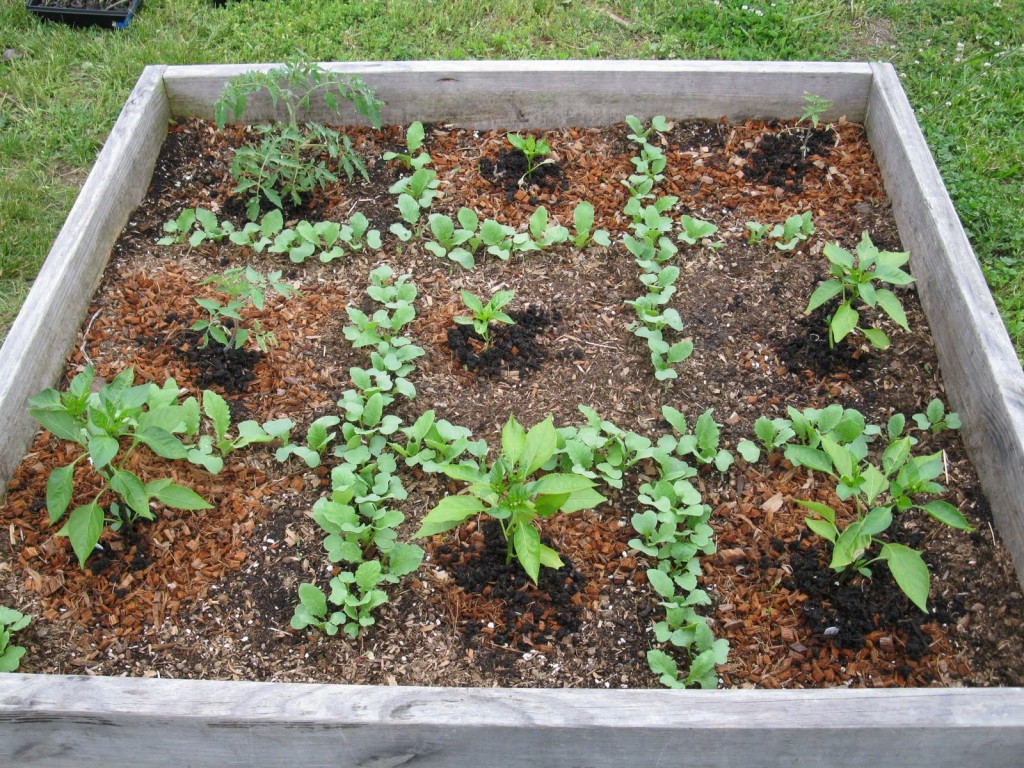from gardenweb.com:
Quick Row-garden-to-Squarefoot translations:
Thin to 12 inches = 1/1
Thin to 6 inches = 4/1
Thin to 4 inches = 9/1
Thin to 3 inches = 16/1
Thin to 2 inches = 36/1
Scatter = scatter (Some things never change….)
Chives = Chia pet in a packet, so who cares? (Besides, it will spread….)
Rosemary: In the South, Rosemary grows to either a 6-ft bush (3-4 ft wide) or a 4-ft (“trailing”) shrub about 4 ft wide. Even with a *lot* of yummy trimming, uprights get about 4 ft tall. If you start fresh each spring, you can certainly go with 4/1, and get lots of tender top growth. (They will live for several years in that size planter.)
Basil, common: Common types are 1/1 in the South, particularly when staked at the ends of your tomato trellises–in which case, expect to harvest often, and a hacksaw will cut the stem at season’s end. (Basil really *likes* maters!)
Basil, the other skazillion types: Better check that growth…. anywhere from 1/1 for globes to 1/4 for the big babies
Mints: All mints need to be in separate 1-ft pots, possibly on solid rock/concrete, and maybe in cages–even their roots mingling underground causes the oils to mix, which changes the flavor of all the plants–probably not in a happy way….. (Works with above-ground growth, too. I had a catmint trail into my peppermint and root. Ahghhhhhh. 😛 )
French marigolds: 4/1
Sacrificial common marigolds come in various sizes and colors: Check the seed packet. Or just plant a border around the edge of the garden, and repeat as eaten….
Purslane (herb-type–you will be disappointed by flower-type): 1/1, trails and spreads–you can try cinderblock holes, if they are large.
Nasturtiums: 4/1 (You can just poke Nastie seeds into cinderblock holes with your finger, and let them trail. Blooms taste like pepper–always remove the bitter center seed-making part from edible flowers!)
Thyme: Varies, but 4/1 is safe for most munchables. Some thymes in the South *can* grow into 1×1 plants, if they survive the winter. Otherwise, you may go with 4/1 if you trim them often or take several big harvests per year.
Chives and garlic chives: maybe just broadcast and cut like sod or plugs for transplanting.
Oreganos: 4/1, bloom stalks can be long, but don’t interfere with anything–Nice to float in a tureen of cold soup; otherwise, clip before they go to seed.
Sages: Varies with variety, but you can probably put all but the really big hummers in 4/1 if you tweak regularly.
Garlic bulb (for greens): 1/1
Garlic: 4/1 or 1/1
Onions: 9/1 or 16/1, depending on size
Shallots: 9/1, I’m told.
Walking onions: 16/1, and watch the little smart alecks.
Horseradish: Pick a remote area at the other extreme from the walking onions, buy a machete, and plan on moving to another property…
Ginger (organicly grown, nonornamental): 1/1
Ginger (ornamental–hey, it still *smells* good!): 1/1
Lemongrass: Plan for a 1/4, about 4 feet tall, like a light-green fountain…. Or keep in a 1/1 pot; water early and often.
Watercress: Plant a few in a shadey tub and apply cold water daily, let spread.
Borage: 4/1 (*Lovely* true-blue flower also tastes of cucumber)
Parsley: 4/1 (Most people think Italian tastes better. Caterpillers aren’t that picky–plant extra for them behind the low flowers in a bed or out of plain view.)
Myrtle: Well, it’s gonna be tree-ish if it lives…. The shrub can be potted for, about a 6-foot shrub.
Bay: 6-foot tree in a pot, 20-foot tree if planted under a tall shade tree
Ginko bilboa: Apply organic tree care plan, prepare tire swing for rapid rise to 70 feet.
Rose: Ummmm, rosehips…. Get organically raised hip producers, plant them according to variety, and give them little garlic chive buddies…..
Savory (winter perennial, summer annual): 4/1 (Rethink it if you can carry over a perennial variety: 1/1 or 1/2)
Lavender: Prolly 1/1, and do *not* drown. (Lavender dies of overwatering, rather than heat. My neglected English lav bloomed in the shade last year–not a lot, but lovely scent….)
Cilantro: 4/1
Coriander: Cilantro seeds
Dill: 4/1, and plant every two weeks for seeds (they bolt). Small young leaves delicious. (Watch out for dropping seeds, and plant extra for the caterpillars.)
Fennel (edible bulb): 1/1 (Burgundy is a beauty!)
Loofah vine: Young gourds are eaten like summer squash, oldies are cured for “sponges”
Chamomille: 4/1 (Self-seeds easily)
Chervil: 1/1
Yarrow: Space 18 inches apart, then start the weed-eater….
Epazote: 1/1. Caution: Herbal guide warning says, POTENTIALLY TOXIC, NOT FOR USE DURING PREGNANCY. You only need one. You will never explain that to the plant. (Mexican culinary herb said to reduce the “gas” problem of a pot of beans. Try really hard to keep it from going to seed….)
Echinacea: 1/1
Fenugreek: 4/1, or to fix nitrogen sow 1 to 2 lbs per 1000 sq ft in the fall.
Gotu kola: Minimum of 1/1, warm and moist — add young leaves to salads and keep the weed-eater handy.
Hyssop, common: 1/4, or maybe 1/2
Hyssop, giant yellow: 1/1 (Yes, the giant one takes less room–go figure)
Sorrel, French: 1/1
Stevia: 1/1 (put little muslin bags over the seed heads next time, so you don’t lose those expensive little seeds….)
Tarragon, Mexican: 1/1 (Leaves bring out the flavor of other herbs)
Bergamot, lemon: 1/1
Bergamot, red-flowered: 1/2 (different species from the lemon bergamot)
Caraway: 1/1 or 2/3



No comments yet, be the first to leave one!
You must be logged in to post a comment.